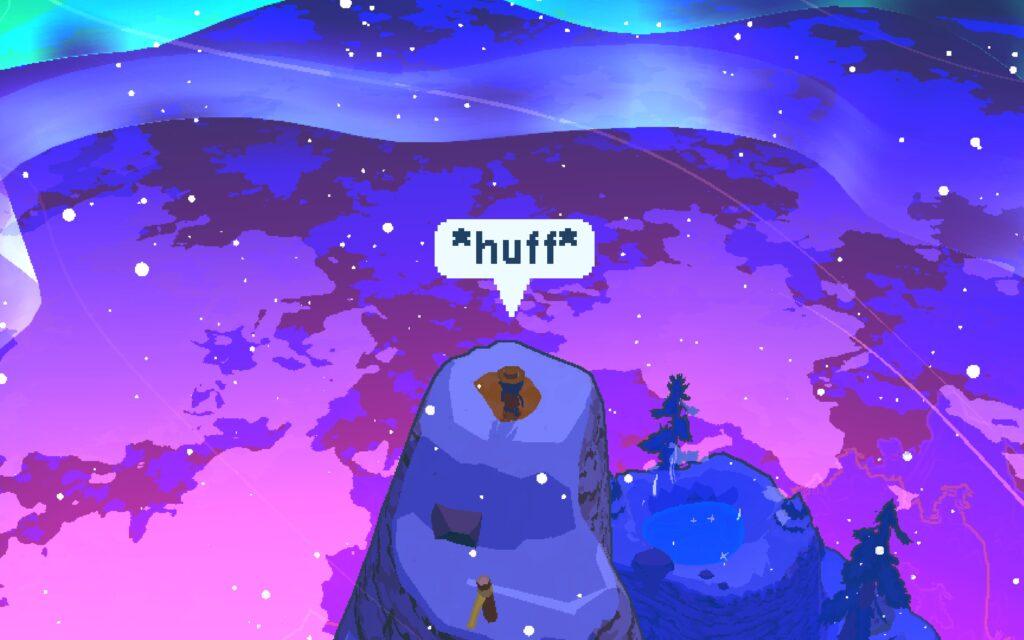For the last few years, I have been meaning to play A Short Hike. Released in 2019 by indie game designer Adam Robinson-Yu, I saw many friends extol its virtues over quarantine. However, I just hadn’t found a chance until just now. As a way to pass the time, it’s a true joy. The characters are memorable, the art style is beautiful, and the flying mechanic was an absolute delight and felt earned as your character Claire got stronger over the course of the story. From a critical standpoint, however, it also serves as a great example of a walking simulator game. These types of games, which focus on exploration and offer the player the primary mechanic of observation rather than more traditional mechanics like combat or puzzles, are sometimes criticized for not having a strong story. However, A Short Hike actually uses the walking (and more generally the movement, as the game allows for climbing and gliding as well, but we will refer to this as “walking” for the purpose of the argument) of the main character as both the premise and motivation of the narrative as well as the pacing device for the story, allowing players to experience it in their own time and with as much supplemental plot as they’d like.
As the name suggests, A Short Hike bases its story around going for a walk, as the main character Claire needs to get cell reception for an important phone call by reaching the top of the mountain. Therefore, the walk is the main quest itself, and both the player and the character have a strong motivation for achieving this goal. This differs from some games in the genre, such as The Stanley Parable or What Remains of Edith Finch, where the goal is to unravel some deeper mystery or break out of your environment. In this way, the movement inherent to the game tells the story because it is the story – without the walk, our character never finishes their journey, physically or emotionally.
Further, the spatial distance and layout of the game map provides built-in pacing to the main narrative, while also allowing for side quests or stories to arise and be resolved organically according to what the player desires. When the game begins, the player has no information about the central storyline or even the identities of the main character. Claire, the protagonist, is only named once the player walks over to the other character scene in the first cutscene. This secondary character is not given a name until even later, after the player has left the first area and walked along the beach. Their relationship to each other is revealed later, and farther from the starting point, still. The game progresses in this way: only revealing new information as the player moves in space, requiring and incentivizing them to explore further and talk with new characters in hopes of earning more pieces of the puzzle. This holds true for the side plots and shorter quests as well. For example, there are several characters for whom their place in the narrative isn’t revealed until the player walks to them and then to some secondary location. This can be to find an item somewhere else on the map that they lost, to collect several items for them over the entire map, or to meet the same character multiple times in different locations. Only through this walking can the player discover the next part of their story, and by choosing not to explore in this way a player has autonomy and influence over the story as it is presented to them.
Throughout the course of its gameplay, A Short Hike utilizes the mechanics of movement through walking, gliding, and climbing to both set up the premise and motivation for the story as well as to allow for user-defined pacing. Slow, methodical exploration of the world creates a fuller understanding of the context and sense of the world, while a quick trip to the top of the mountain paints the picture of a more contained plotline. No matter how the player chooses to complete their hike, however, the game uses its position as a walking simulator to keep them compelled throughout, discovering new, narratively-critical information as they go and completing Claire’s emotional and physical journeys to Hawk’s Peak.
The view from the top of the mountain from my playthrough of the game, right before the central mystery of Claire’s important phone call is revealed. Only through completing this climb can we get to the end of the narrative. Here, the peak of the mountain is also the peak of the story!



